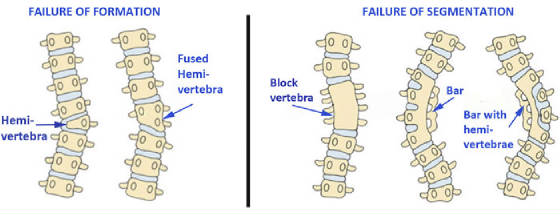|
When you think about scoliosis, the first thing that comes to mind is idiopathic scoliosis (which just means that the spine curves for no known reason, with no changes in the actual bones
of the spine). This is the typical kind of scoliosis you hear of, when children
get checked at the doctor or school by bending over to see if their back is straight.
However, there is a rarer subset of scoliosis called
Congenital scoliosis, which is when the spine curves as a result of malformations
of the vertebra, or bones in the spine. Congenital Scoliosis accounts for only
about 15% of all cases of Scoliosis. This type of scoliosis is present from birth
and in some cases can progress very rapidly. Where the malformed vertebra are, what type of malformations are present and how much growth potential the bones have
will determine if the spine will remain fairly straight, curve only a little, or curve a lot.
There are three “groups” of causes for congenital scoliosis :
-
Failure of Formation – when an individual vertebra fails to form properly, the most common example of this is
a hemivertebra (literally, half vertebra) where the vertebra is a pie shaped wedge instead of a rectangle. Another type is a “butterfly” vertebra, where it looks like the middle of the vertebra has
been pinched until it broke apart, or two wedges on either side meeting in the middle.
-
Failure of Segmentation - when the vertebra fail to separate early in
development, and you have two or more vertebra “stuck” together. The
most common type is called block vertebra, when two or more vertebra are fused together in between the bones. Another more serious type of segmentation error is called a congenital bar, when one side of the bone mass
is fused together, but the other side is open and can grow.
-
The third group is a combination of both of the above. Sometimes you can
have both types of issues in different areas of the spine. Many times, a child WILL
have a combination of different types of anomalies. One of the more serious forms of congenital scoliosis is
when you have a congenital bar on one side with hemivertebra on the other side in the same location, as this curve can progress
rapidly with growth.

At the same time as the spine develops, other midline structures such the bladder, kidneys, and heart
are developing. As a result, you often see other anomalies go along with congenital
scoliosis. Some of the most common issues seen are kidney/bladder anomalies , malformations
of the spinal cord (see your doctor if you see skin markers such as dimples, red spots or hairy patches over the skin of the
back over the spine), and heart defects.
If your child is diagnosed with congenital scoliosis, they should have a thorough
physical examination to rule out those associated congenital anomalies. An ultrasound
of the kidneys, echocardiogram of the heart and MRI of the spinal cord can be done to find
issues which may cause problems in the future if undiscovered and not treated. An
xray of the spine will show if congenital scoliosis is present, and help your doctor determine what type of anomalies are
present and help predict the long term growth of the anomalies and the curve. Regular
xrays will be taken as your child grows, to monitor the curve.Taking x-rays of the entire spine will determine if congenital
scoliosis is present. X-rays will also allow your doctor to determine the type and severity of the congenital vertebral malformations,
which helps predict the long-term risk that your child's curve may get worse with growth. A renal ultrasound is usually recommended
as part of the routine screening assessment if congenital scoliosis has been confirmed. An MRI of the spinal cord may be indicated
if there is suspicion of a spinal cord abnormality or unexplained rapid progression of the curve."
Note – I’m just a mom here, with
a child that has congenital scoliosis. I’ve tried to look at different
medical websites, and condense and paraphrase the information in a readable way for the average lay person who does not speak
“medical” for a living. I’ve developed this site to help others
better explain congenital scoliosis to their friends and family (or just to have a place to send them, when they have questions).
|

